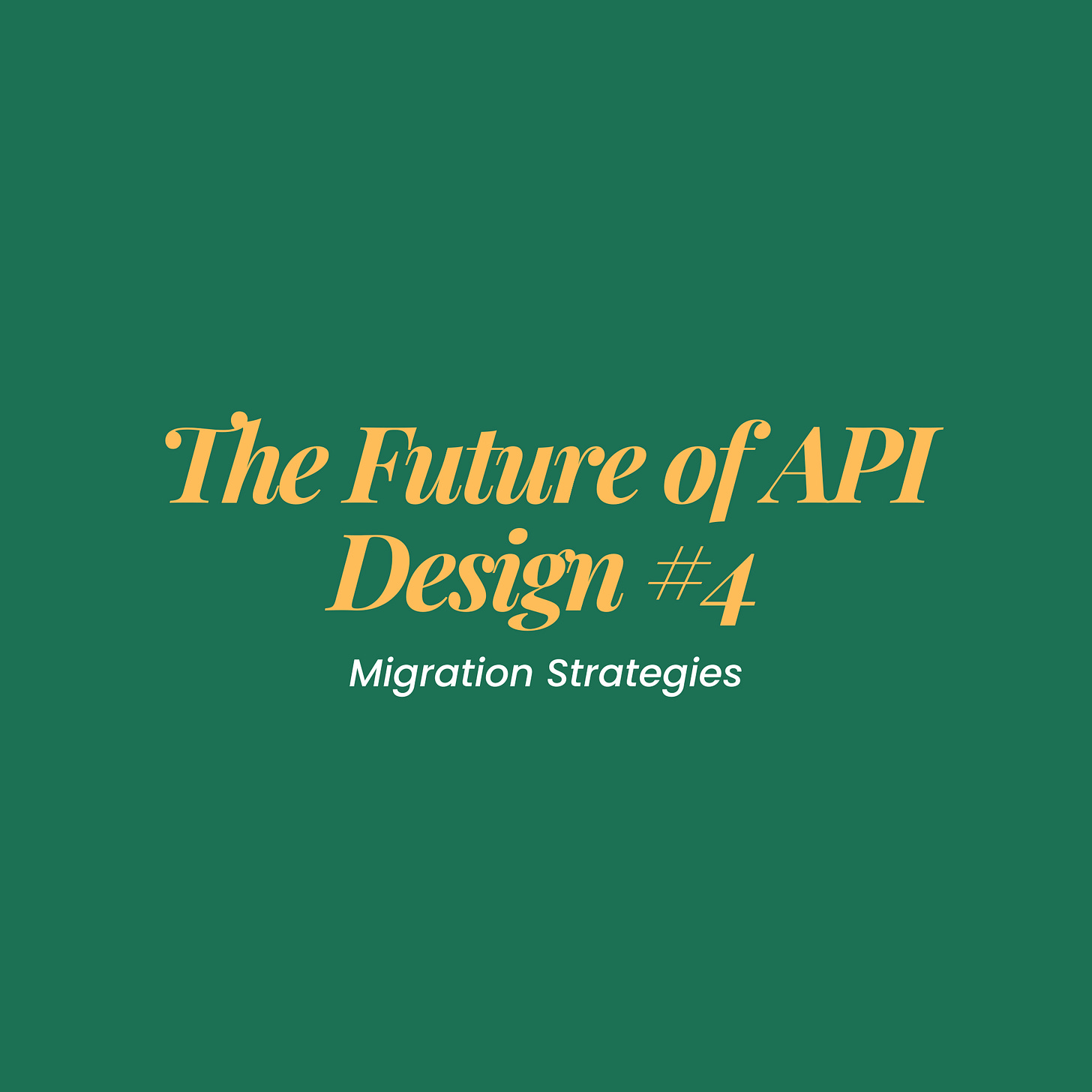The Future of API Design: Migration Strategies
♻️ Knowledge seeks community 🫶 #16
Hello 👋,
Welcome back to Stef’s Dev Notes and The Future of API Design series !
This is Article #4 from this series.
If you’ve been following along, you know this series explores how APIs evolve, not just as interfaces, but as living systems that shape how we build software.
APIs evolve. Not just in how they’re built, but in how they survive change.
Versioning, compatibility, and schema evolution aren’t new concepts, but they’ve become harder to manage as systems grow more interconnected.
Most migration challenges don’t come from the version number, they come from design debt. Teams often inherit data-dump APIs: endpoints that expose too much, serve too many purposes, and blur the lines between systems.
Migration, in this sense, isn’t just a technical rewrite, it’s a chance to rethink the purpose of your API, aligning it closer to how the product actually works.
In this article, we’ll look at migration strategies, how to evolve your APIs without breaking the ecosystem around them.
And more importantly, how AI might reshape this process in the near future.
There’s a quiet truth in software development: APIs rarely fail at version 1.0, they fail when version 1.1 arrives.
Not because the new version is bad, but because something changed and everything connected to it started to wobble.
We spend so much time talking about designing APIs right, but far less about designing them to change right.
Yet the real test of an API’s design comes the moment it needs to evolve.
The future of API design isn’t about getting it perfect from the start.
It’s about creating systems that can adapt gracefully without leaving their users behind.
Why Migration Matters More Than Ever
APIs have become the glue of digital ecosystems, powering SaaS integrations, internal microservices, and public developer platforms.
And when the glue changes, everything connected to it feels it.
Migration used to be a rare event, something you planned for once a year.
Now, it’s continuous.
Teams ship new endpoints weekly, sometimes daily.
The line between iteration and migration has blurred.
In this reality, resilience comes not from stability, but from flexibility.
The APIs that will stand the test of time are those designed to evolve, to anticipate change rather than fear it.
The Old Model: Breaking and Rebuilding
For years, we treated change like a controlled explosion:/v1 → /v2 → /v3.
A clean version, a clean slate.
But each new version brought new documentation, new clients, new confusion, and often, a group of users quietly left behind.
Versioning brought order, but it also created fragmentation.
Every version became its own ecosystem, hard to maintain and unify.
That approach worked when APIs were internal or when the consumer base was small.
But in today’s connected world, where thousands of clients depend on your interface, a breaking change is no longer just a technical issue, it’s a breach of trust.
The Future Model - Continuous Evolution
The next phase of API design will move away from abrupt version jumps towards continuous evolution.
Migrations will feel less like “events” and more like “flows.”
We’re already seeing early signs of this:
Graceful deprecation instead of instant removal
Consumer-driven contracts, ensuring changes respect real-world usage
Schema validation and automated diffing to catch breaking changes before deployment
Runtime version negotiation to serve older consumers without blocking progress
Imagine a CI pipeline that warns you when a schema change would break existing consumers.
Or a dashboard that shows how many clients still depend on deprecated endpoints.
Or even a migration assistant that generates compatibility layers automatically.
The future of API design lies in continuous, intelligent adaptation, guided by feedback, telemetry and data, not just design assumptions.
Migration Is a Conversation
No matter how technical migrations get, they remain deeply human.
Every API migration is a conversation between provider and consumer:
“I’m changing something, here’s what you need to know.”
That’s why transparency matters just as much as technical precision.
Clear change logs.
Early communication.
Feedback channels that actually listen.
Migration is not just about code; it’s about trust.
And trust is built through clarity, empathy, and the shared goal of improvement.
The future will only amplify this. AI-powered design tools, collaborative platforms, and integrated feedback loops will make this conversation smoother.
But the principle will remain the same: communicate before you change.
Migration Maturity Model
As teams evolve, their migration practices mature from reactive fixes to proactive evolution.
Here’s how that progression often looks:
Each level reflects a shift, not just in tooling, but in how teams think about change.
At Level 1, migrations are something you “handle.”
At Level 4, they become something your system anticipates.
Reaching the higher levels of this model isn’t just about automation, it’s also about trust.
Trust in your contracts, in your observability, and ultimately, in your systems’ ability to adapt safely.
Once those foundations are in place, the question becomes:
What if migrations didn’t need our constant supervision at all?
That’s where things start to get interesting.
A Glimpse Ahead - APIs That Migrate Themselves
If we look further ahead, the idea of “manual migration” might start to fade away. Instead of writing migration plans or manually comparing schemas, we might have AI systems that observe usage patterns, detect breaking changes, and automatically suggest migration paths.
Imagine a system that scans your traffic, identifies deprecated endpoints still in use, and quietly generates compatibility layers or proxy routes to keep them running.
It could even create auto-generated change logs or developer upgrade guides based on real usage data.
Scary, right?
We might even see self-healing APIs, ones that detect deprecated calls and reroute them automatically to their new structure.
It sounds futuristic now, but I don’t think it’s all that far-fetched.
The building blocks are already here:
Schema registries (AsyncAPI, Apollo Federation for GraphQL) that track and version contracts across services.
Observability pipelines (OpenTelemetry, Datadog, Honeycomb) that trace every API call.
Contract validation tools (Pact, OpenAPI Diff, Spectral) that detect breaking changes before they reach production.
AI-assisted code analysis that can suggest safe refactors or even generate backward-compatible adapters.
Before APIs can self-heal, they first need to self-observe.
That’s where the real evolution begins, when systems start learning from their own usage.
The future of API design won’t be about preventing change, but about orchestrating it intelligently.
As our architectures become more modular and our feedback loops tighter, APIs will move from static contracts to adaptive systems that evolve alongside the products and the people they serve.
Closing Thought
Every migration starts as a technical problem, but it ends as a design decision.
Escaping data-dump APIs isn’t just about cleaner schemas; it’s about rediscovering intent.
As AI begins to shape how systems evolve, the role of the developer shifts from fixing legacy design to guiding its next iteration, defining boundaries, refining purpose, and teaching the system what “good” actually means.
The future of migration might be automated, but its direction will still come from us, the ones who understand not just how APIs work, but why they should.
Until next time,
Stefania
✳️ If you enjoyed this piece
Check out the previous article from The Future of API Design series:
👉 The Future of API Design & Collaboration
Next time, we’ll explore how even well-designed APIs can drift from their original purpose and how to realign them without starting over.
Articles from the ♻️ Knowledge seeks community 🫶 collection: https://stefsdevnotes.substack.com/t/knowledgeseekscommunity
Articles from the ✨ Frontend Shorts collection:
https://stefsdevnotes.substack.com/t/frontendshorts
👋 Get in touch
Feel free to reach out to me, here, on Substack or on LinkedIn.






This piece really made me think. You've brilliantly highlighted how design debt, not just versioning, is the true chalenge. As someone passionate about AI, I'm especially keen on exploring how it could proactively detect and mitigate these 'data-dump' issues, preventing future migration headaches. Excellent analysis.